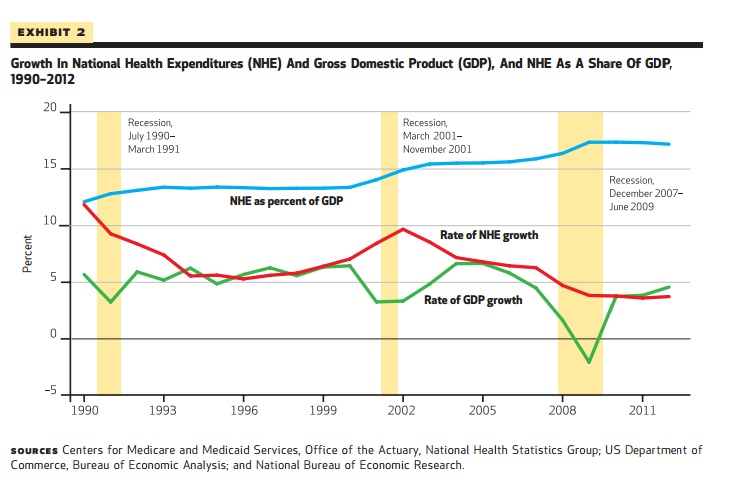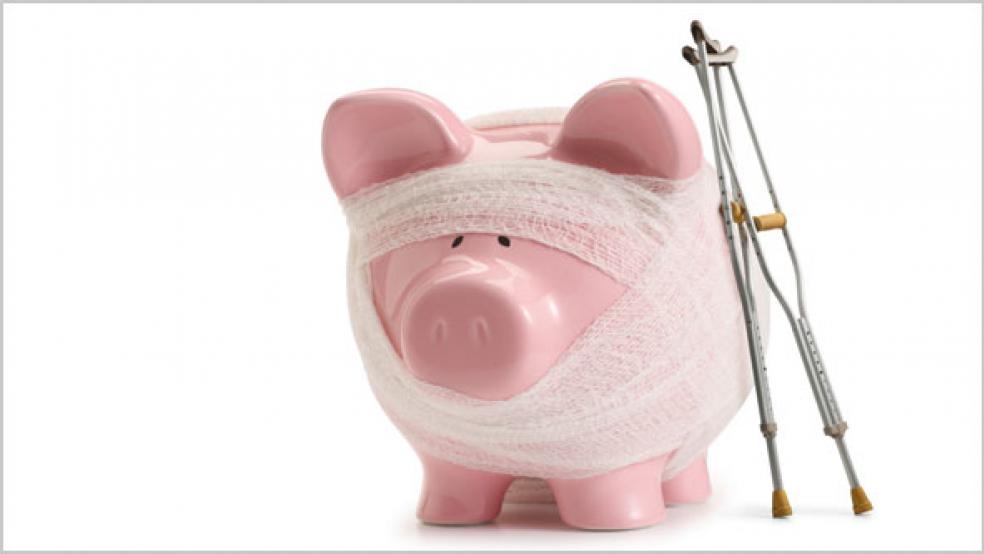Something big has been happening in U.S. health care, and it isn’t President Obama’s reform law: Since 2009, health care costs have risen between 3.6 and 3.8 percent a year, the slowest rates on record. That trend continued for a fourth straight year in 2012, as spending increased a relatively modest 3.7 percent, according to a report released Monday by Medicare actuaries.
For the first time since 1997, spending on health care as a share of gross domestic product edged lower, dropping to 17.2 percent from 17.3 percent in 2011. That still represents a greater share of the economy than in other developed countries, but it offers hope that the U.S. may be getting a much-needed handle on those spiraling costs.
Related: The Unintended Consequence of Expanding Medicaid
For decades, health spending grew at a far faster rate than the economy overall, jumping more than 10 percent a year for much of the 1970s and 1980s. Since 1960, health spending has increased an average of 4.3 percent, 2.3 points faster than GDP growth per capita, according to a Commonwealth Fund report published last month in the New England Journal of Medicine.
As a result, health care spending ballooned from about 5 percent of the economy in 1960 to its current levels closer to 20 percent. Overall health care spending totaled $2.79 trillion in 2012, or about $8,915 per person, according to data from the Office of the Actuary at the Centers for Medicare & Medicaid Services.
The upward trajectory of the health spending curve flattened out some in the 1990s before spiking again. It started to fall again in the early 2000s and then really took a dive, along with the economy, as the Great Recession took hold.

Analysts remain divided over exactly why that’s happened and whether it can continue. The more dramatic slowdown has coincided with the implementation of the Affordable Care Act, which President Obama signed into law in 2010, and Jason Furman, chair of the White House Council of Economic Advisers, wrote in The Wall Street Journal on Monday evening that the law had played a part in the progress. The Medicare actuaries, though, said that the reform law “had a minimal impact on overall national health spending growth through 2012.”
The Medicare economists and other health care researchers say that the recession and its lingering effects is primarily responsible for having kept spending low. “The low rates of national health spending growth and relative stability since 2009 primarily reflect the lagged impacts of the recent severe economic recession,” Anne B. Martin, an economist in the Office of the Actuary at CMS, said. “Additionally, 2012 was impacted by the mostly one-time effects of a large number of blockbuster prescription drugs losing patent protection and a Medicare payment reduction to skilled nursing facilities.”
Related: Government Blatantly Wastes $30 Billion This Year
On top of that, enrollment in private health insurance plans was still 9.4 million lower in 2012 than it had been in 2007, the report said, and “this declining enrollment was a major factor in the slow growth in overall private health insurance spending over the past several years.”
Other experts, though, have pointed out that the reining in of rapidly escalating health care spending began before the Great Recession and should continue even as the economy returns to more normal growth rates. “There’s something that’s been building, and it preceded the recession. The recession certainly added to it, but the growth rates for all these payers, whether it’s private, Medicare or Medicaid, started to slow before 2008, so it couldn’t have been the last recession that was causing it all,” said John Holahan, director of The Urban Institute's Health Policy Center. “Poor economic activity for a long period of time has reduced the revenue flows into the health system, which has caused a structural change.”
In an analysis last November, the White House’s Council of Economic Advisers said that the causes of the slowdown aren’t fully understood yet, but concluded that economic cycles weren’t the only factor at play. “The slowdown in health care cost growth is more than just an artifact of the 2007-2009 recession: something has changed,” the report said. Those “structural” changes suggest that the slowdown in spending is likely to continue, the report said.
Related: The Hidden Impact of Obamacare and the Economy
In their new report, Medicare’s economists said it was too soon to conclude that those more fundamental changes were real and lasting. “From our perspective, more historical evidence is needed before concluding that we have observed a structural break in the historical relationship between the health sector and the overall economy,” Martin and her colleagues wrote in the journal Health Affairs.
Whatever the causes of the larger trend, the overall health spending picture may mean less to your family’s finances than the details of how and why costs have been climbing. Out-of-pocket spending, for example, grew 3.8 percent, up from 3.5 percent in 2011, as consumers shared more of the costs of doctors and clinics. Americans spent 4.9 percent more on hospitals in 2012 ($882 billion) and 4.6 percent more on doctors and other clinical services ($565 billion). Premiums for private health insurance grew 3.2 percent, the fifth straight year of relatively low growth. And spending on nursing homes climbed by 1.6 percent as the result of a one-time reduction in Medicare payments.
Spending on medications played a large role in slowing overall costs. Outlays for retail prescription drugs grew just 0.4 percent to $263.3 billion, down from 2.5 percent growth in 2011. “This reduced growth rate was driven largely by a slowdown in overall prices paid for retail prescription drugs as numerous brand-name blockbuster drugs (most notably Lipitor, Plavix, and Singulair) lost patent protection in late 2011 and in 2012 and as generic versions became available,” the Health Affairs report noted. The share of lower-cost generics among all prescriptions jumped by almost 8 percentage points, to 77 percent.
While those blockbuster drugs coming off patent will mostly have a one-time effect on costs, a number of broader trends will continue to shape health care spending. If the recent spending shifts are linked closely to the economy, for example, costs could spike again as growth improves. Millions of Americans have and will gain access to health insurance under the Affordable Care Act or its expanded access to Medicaid, and enrollment in Medicare jumped by 4.1 percent in 2012, the largest such increase in 39 years – but one that will continue as more aging baby boomers become eligible for the program.
"To be sure, the ACA's measures to expand and improve coverage will temporarily increase the growth of national health expenditures, but they will not negate these trends toward slower growth in prices and cost per beneficiary throughout the health system," White House economist Furman wrote in his Wall Street Journal op-ed Monday.
It’s not clear yet just how much the new law and other systemic changes will increase health care spending and whether the long-term trend can really continue. The Centers for Medicare & Medicaid Services will release its 10-year projections, including estimates of the impact of Obamacare, later this year.
Top Reads from The Fiscal Times:





